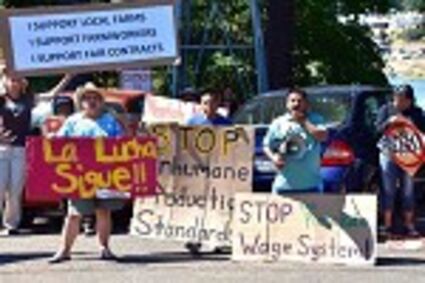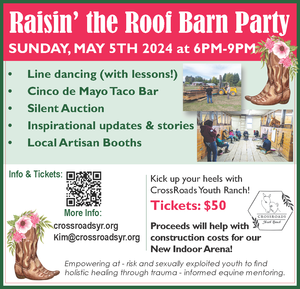Protestors besiege Historical Museum
August 12, 2015

PROTESTORS – A group of about three dozen people stood outside the Skagit County Historical Museum on Sunday to make sure their voices were heard during a presentation by farmer Steve Sakuma. At the right with the megaphone is Filemon Peneda, of the Familias Unidas farm worker union. – Photo by Don Coyote
A presentation by Steve Sakuma, the recently retired CEO of Sakuma Brothers Farms, was overshadowed on Sunday by around three dozen protestors and union representatives, who marched through La Conner to the Skagit County Histor-ical Museum, demanding that Sakuma negotiate with farm workers.
The protests, which lasted the length of the lecture, ended without incident but provided some tense moments as some protestors entered to watch the lecture and Skagit County Sheriff’s deputies were called in to monitor the crowd.
Sakuma Berry Farms has battled in court with the farm workers union, Familias Unidas Por la Justicia, which in Spanish is “Families United for Justice.” For several years, the valley’s largest berry farm company has seen itself embroiled in a labor dispute.
According to the Familias website, Boycott Sakuma Berries, the union has been involved in labor disputes for at least the past decade on Sakuma Farms.
In 2013, workers held six strikes during harvest season to protest what they considered unfair wages and poor living conditions in labor camps, and perceived hostility from management. They won concessions including wage increases, housing improvements, and management changes.
A 2014 dispute over wages ended with an $850,000 settlement. Cases in Skagit County Superior Court as well as the Washington State Supreme Court have brought workers’ families into Sakuma housing and paid breaks, respectively.
According to protestors, however, Sakuma has not done enough.
“A union contract is the only way workers will be helped,” said Felimon Pineda, vice president of Familias Unidas, speaking through a translator. “We’re tired of the exploitation.”
The protestors began their march at Maple Hall, before proceeding up Douglas and Fourth streets to stop outside the Skagit County Historical Museum.
Of the group, perhaps two thirds said they were workers or family members of people who had worked in Sakuma Farm fields. They were joined by representatives of other unions, some college students, and others.
While many activists focused on union recognition as the sole goal for the protest, some also cited the lack of representation of farm workers in the Historical Museum’s Back to Our Roots exhibit.
“They flat out refused,” said Patrick Neville, a representative from the Washington Public Employees Association, estimat-ing that the protestors had called the museum at least 20 times. “How does it get to your table?”
The Back to Our Roots exhibit, which featured Steve Sakuma as a guest speaker, is intended to give visitors an image of what life was like for the earliest settlers in Skagit County, said Jo Wolfe, the public relations representative for the museum.
“It’s really about telling the stories of the pioneers,” she said.
Steve Sakuma, whose family came to the valley in the 1930s, was brought in because of popular demand, she said.
Wolfe said the museum had heard very little criticism about the Back to Our Roots exhibit.
“I am aware of one phone call,” she said.
Wolfe said that in the near future the museum plans to reach out to the farm workers to help develop an exhibit in the near future, “specifically telling the story of the Hispanic community in the valley.”
Sakuma’s presentation was well attended, and some visitors had to stand in the back due to a lack of chairs.
He went over the family’s history in the valley, noting the expansion of the business following the family’s internment during World War II, when they joined more than 100,000 other Americans of Japanese ancestry who were imprisoned across the western United States.
He also discussed in general terms the work behind strawberry farming, and what he listed as the biggest challenges with farming in the Skagit County, including labor shortages and “regulatory oversight.”
The latter half of the presentation, however, focused in-depth on the pay system and conditions at the business’s farm labor housing, an indication that labor disputes remain an important part of the Sakuma Brothers public face.
“We’ve played by the strictest rules because we’ve had a microscope put on us,” said Sakuma in his presentation.
“I think it’s the price of doing business,” Sakuma said, discussing the disputes after the presentation. “We’re big, and we have a lot of people.”
Sakuma Brothers Farms employs 300 to 400 farm workers annually and brings in roughly $6 million in net revenue.
Around the second half of his talk, a group of 10 protestors bought tickets to the lecture and stood in the back of the room because there were no seats left.
Following the lecture, museum Director Kelly Molestead said he was impressed with the lecture and happy that the protestors did not disrupt the event.
“They were very respectful,” he said.
“This is the only way workers can be visible,” said Edgar Franks, one of the protestors who stood in on the lecture. “The ball’s really in their court.”











Reader Comments(0)